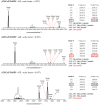Delineating Host-Guest-Solvent Interactions in Solution from Gas-Phase Host-Guest Configurations: Thermodynamic Reversal and Structural Correlation of 24-Crown-8/H+/Diaminopropanol Non-Covalent Complexes in Aqueous Solution vs. in the Gas Phase
- PMID: 40333634
- PMCID: PMC12029154
- DOI: 10.3390/molecules30081723
Delineating Host-Guest-Solvent Interactions in Solution from Gas-Phase Host-Guest Configurations: Thermodynamic Reversal and Structural Correlation of 24-Crown-8/H+/Diaminopropanol Non-Covalent Complexes in Aqueous Solution vs. in the Gas Phase
Abstract
We study the structures of 24-crown-8/H+/diaminopropanol (CR/DAPH+) and 24-crown-8/CsF/H+/diaminopropanol (CR/CsF/DAPH+) non-covalent host-guest complexes in both the gas phase and aqueous solution using the density functional theory (DFT) method. We examine the environment (complexation with CR vs. solvation) around the guest functional groups (ammoium, hydroxyl, and amino) in the CR/DAPH+ and CR/CsF/DAPH+ complexes. We find that the gas-phase configurations with the 'naked' hydroxyl/amino devoid of H-bonding with CR or CR/CsF are structurally correlated with the lowest Gibbs free energy conformers in aqueous solution in which the functional groups are solvated off the CR or CR/CsF host. We predict that the latter thermodynamically disadvantageous host-guest configurations would be identified in the gas phase by infrared multiphoton dissociation (IRMPD) spectroscopy, originating from the complexes in aqueous solution. This predicted 'thermodynamic reversal' and 'structural correlation' of the host-guest configurations in the gas phase vs. in solution are discussed in relation to the possibility of obtaining information on host-guest-solvent interactions in the solution phase from the gas-phase host-guest configurations.
Keywords: crown ether; diaminopropanol; host–guest; structural correlation.
Conflict of interest statement
The authors declare no conflicts of interest.
Figures








Similar articles
-
Thermodynamic Reversal and Structural Correlation of 24-Crown-8/Protonated Tryptophan and 24-Crown 8/Protonated Serine Noncovalent Complexes in the Gas Phase vs in Solution: Quantum Chemical Analysis.ACS Omega. 2024 May 23;9(22):23793-23801. doi: 10.1021/acsomega.4c01782. eCollection 2024 Jun 4. ACS Omega. 2024. PMID: 38854571 Free PMC article.
-
Probing the hydroxyl in [2,2,2]-cryptand/KF/choline chloride non-covalent host-guest complex in solution by 19F-NMR spectroscopy: structural correlation and thermodynamic reversal of host-guest configurations in solution and in the gas phase.Phys Chem Chem Phys. 2025 Jul 10;27(27):14391-14396. doi: 10.1039/d5cp01548k. Phys Chem Chem Phys. 2025. PMID: 40557549
-
Unveiling host-guest-solvent interactions in solution by identifying highly unstable host-guest configurations in thermal non-equilibrium gas phase.Sci Rep. 2022 May 17;12(1):8169. doi: 10.1038/s41598-022-12226-0. Sci Rep. 2022. PMID: 35581255 Free PMC article.
-
Noncovalent Complexes of Cyclodextrin with Small Organic Molecules: Applications and Insights into Host-Guest Interactions in the Gas Phase and Condensed Phase.Molecules. 2020 Sep 4;25(18):4048. doi: 10.3390/molecules25184048. Molecules. 2020. PMID: 32899713 Free PMC article. Review.
-
Crown Ether Host-Guest Molecular Ferroelectrics.Chemistry. 2022 Jan 24;28(5):e202102990. doi: 10.1002/chem.202102990. Epub 2021 Dec 2. Chemistry. 2022. PMID: 34792222 Review.
References
-
- Schalley C.A. Supramolecular chemistry goes gas phase: The mass spectrometric examination of noncovalent interactions in host–guest chemistry and molecular recognition. Int. J. Mass Spectrom. 2000;194:11–39. doi: 10.1016/S1387-3806(99)00243-2. - DOI
Grants and funding
LinkOut - more resources
Full Text Sources

